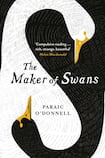
'Look on my works, ye mighty, and despair!" The cry of Shelley's Ozymandias in that great poem about immortality and art come to mind when reading Paraic O'Donnell's debut novel. Linguistically inventive and self-assured in style, The Maker of Swans is more concerned with art and writing than with story. Wordplay, anagrams, characters with similar sounding names, and a plot that revolves around extraordinary literary abilities ensure that the power of the written word stays constant in the reader's mind.
The focus is on the creation process, and how a blank space or page turns into something. Using two main narrators and some side perspectives, O’Donnell creates an atmospheric and gothic world that wavers between fantasy and reality.
A fevered beginning sees Mr Crowe, the eccentric owner of a rundown English mansion, kill his girlfriend’s ex on the grounds. Mr Crowe’s butler, Eustace, one of the central characters, attempts to clean up the mess in an engaging section that pits the reserved tones of an old-school butler against the devil-may- care attitude of his employer.
A switch in voice brings us to Clara, the young ward of Mr Crowe. Clara never speaks, instead filling countless notebooks with her observations, “hoarding them as other children do seashells or brightly coloured stones”. Both Clara and Mr Crowe have talents beyond the scope of normal human endeavour.
The ethereal Clara has memorised any number of great novels and can recount them on request. More impressive still, she can apparently create actual physical entities such as the titular swans that she imagines into being. Her guardian, meanwhile, is the author of many a literary masterpiece over the centuries.
As Eustace uncovers more about the murder victim, we learn that these remarkable gifts have drawn unwanted attention from an elusive Order that covets his output. There is plenty of tension in the book’s first half as the house prepares for a visit from the Order’s malevolent Dr Chastern and his aide, Nazaire. Time and setting are alluded to but deliberately vague, feeding O’Donnell’s eerie and dreamlike world.
The gothic overtones add to the atmosphere – rambling mansions, a maze in the grounds, villains lurking in the shadows, heavies called in to defend the house, imagery of light and darkness, attention to colour – and highlight a main theme: that the past comes to haunt, that all accounts must eventually be settled. The characters go back when they can no longer go forward, seeking “the vanished thing that gleamed still among the reeds”.
Fading mystery
A shift to the back story of Mr Crowe and Eustace in the second half fits well with this theme but slows the pace considerably. While Clara is whisked away by Chastern (spot the anagram that describes the action) and Mr Crowe turns to alcohol, Eustace finds himself involved in bar brawls after falling in love with a prostitute. The narrative is disjointed in these later sections, with the mystery fading to insignificance.
Without an engaging plot to sustain it, the novel’s preoccupation with literariness and its grand themes of memory, creation, and the blurring of art and reality can grate. Creating something out of nothing, as the book persistently tells us, proves difficult.
O’Donnell has his characters banter about the storytelling process – “Get things moving, that’s all that matters, and do not trouble yourself at occasional creaking from the scenery”. And yet, for all the knowing winks, the novel’s own narrative momentum is not sustained.
There is, however, plenty of intertextuality that does work, from the lovely fairytale of the king and the nightingale, to passages from Troilus and Cressida and references to Madame Bovary and Treasure Island. The clever dynamic between Mr Crowe and his nemesis Chastern allows O'Donnell to explore literature, which he does using witty, intellectualised dialogue reminiscent of Frasier and Niles Crane having a disagreement.
Elsewhere, a poetic style draws attention to detail, from the “white haft of skin” of Mr Crowe’s leg to Eustace sipping his whiskey and feeling the “coarse flare of heat at the back of his throat”. The formal tone also has glints of humour, such as Mr Crowe’s attitude to the sometimes overbearing Eustace, whose questioning is “like being trapped in a tea-room with a lady detective”.
O’Donnell, who lives in Wicklow with his family, writes fiction, poetry and literary criticism. His improvised Twitter short stories have earned him an audience in recent years. His intriguing debut novel is an ambitious and original work that will likely divide readers. It will be interesting to see what this maker of swans makes next. Sarah Gilmartin is an arts journalist












